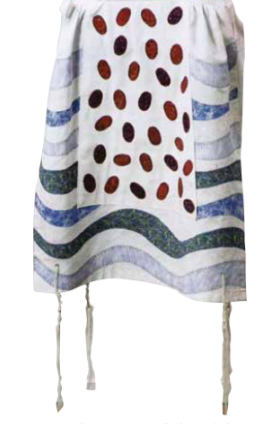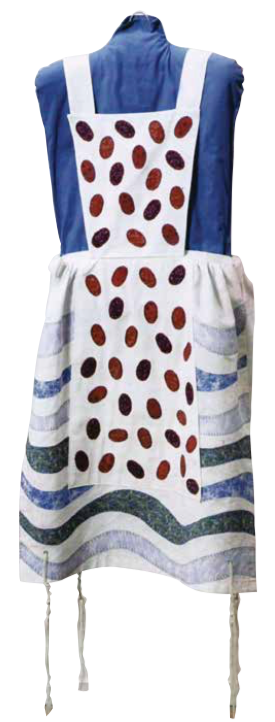
from “How Do Women Define the Sacred?”
A slew of insights into a different kind of holiness through the bold, idiosyncratic and deeply personal prayer shawls women are creating for themselves. [Fall 2006]

Art: “Fringed Garment,” a tallit by Rachel Kanter
Several issues ago, Lilith put out a call asking women who wore tallesim [plural of tallis; tallit in modern Hebrew]—traditionally men’s prayer shawls—to tell us about them, and the response was overwhelming.
Though women have become increasingly enfranchised over the past several decades in many areas of Jewish life, our gains in the world of liturgy and worship arc nominal, and prayer remains a legacy almost entirely composed and transmitted by and for men. Handmade women’s tallitot offer the beginnings of a serious challenge to that. They are not, it turns out, just aesthetic tweaks on men’s unchanging-through-the-millennia wool or rayon prayer shawls, but rather communiques from a distinctly gendered spiritual front. Females in their hand-made tallitot are Trojan horses in the pews: the beginnings of what will be, over time, a recasting of the patriarchal davennen [prayer] that has been Jews’ inheritance.
These tallesim also reveal how gendered one’s experience of the sacred actually is. Century after century, men have largely been completely happy to don the identical sacerdotal rectangles as one another. Women’s tallitot, however, almost immediately morphed into individualized and exuberantly self-expressive garments, providing Jews with a wonderful window into how women experience the sacred. Opening the synagogue doors to females also opened the doors onto female sensibilities, and so the tallit, as one woman told us, reflects “everything that was left out; everything that women find holy that doesn’t yet have a place in conventional Jewish worship.”
Jewish women have historically been excluded, until late, from formal synagogue worship, but the received cant that “women stayed at home while men went to shul to pray” is patently false. It exposes a narrow and tendentious framing—and a deep misunderstanding —of prayer and the spiritual. Women’s homes, indeed, are and have always been “shuls,” and we —our mothers, grandmothers, great-grandmothers, our friends’ mothers—have reigned supreme there as autonomous “priests,” freed from clerical supervision….
Clothing is many women’s “first language,” connecting us to everything from shopping to the ancient female craft of weaving. The sensuousness of cloth, its textures and colors, also speaks to women. Thus the choosing or making of a tallit can be an accessible and natural way for women to interact with traditional Judaism.
Women are moved by the physicality of a tallit’s embrace, as well as its talismanic power to protect. Many women who wear handmade tallitot value that their prayer shawls define a private space, discrete and powerful—words used by informants include: tent, membrane, chador, womb, and even, interestingly, “a room of one’s own.”
It is a canard to think of women as entering temples and synagogues as religious novitiates, as the gender that has been excluded for over two thousand years from authentic “worship.” Instead it’s that men were in one shul and women in another. And our ever-evolving tallitot reflect our bringing into the public agora, for the first time in history, our religious experience, our definition of what we find holy, our “domestic faith,” our sacralizing of stories and relationships, beauty, and the sensorial and embodied….
We can sit in synagogue, now, and enjoy the two spheres that are both necessary to our experience of the sacred: one shared and formal, the other intimate and private. Rachel Kanter, of Manhattan, wrote: “My tallitot are no longer just pieces of fabric to hold the four tzitzit [fringes]. They are a means of connecting my story as a woman with my story as a Jew.”


